#viennese modernism
Explore tagged Tumblr posts
Text

Haus Steiner, Wien, Österreich. Adolf Loos. 1910.
#adolf loos#modernism#modernist architecture#vienna#austria#viennese architecture#viennese modernism#architektur#wien#österreich#modernismus
123 notes
·
View notes
Text

Erika Giovanna Klien
Tanz (Dance), 1931 Watercolor and pencil on cardboard.
#erika giovanna klien#viennese kineticism#kineticism#art#modern art#austrian art#painting#watercolor painting
124 notes
·
View notes
Photo

Moa, 1911 von Egon Schiele
#egon schiele#schiele#moa#reform#österreich#austria#digital artist#modern art#art#artwork#kunstwerk#kunst#portrait#expressionism#vienna#viennese#austrian#painting#woman
15 notes
·
View notes
Text
autumn court inspired by germanic folklore & fairytales, my beloved
#the autumn court in general owns my heart. everyone else is in a romance novel & they're in game of thrones.#the temptation to develop the entire court and its regions.#imagine lesser fae based on the waldleute & changelings (both very fitting for autumn)#feldgeister hidden in the rows of corn. the bergmönch in the mountains. yule witches in their huts.#wolpetingers rustling in the trees. eris' 12 helhonds.#the lorelei singing atop the rocks by the sea.#gothic bavarian-style architecture. viennese-baroque palaces. wild countryside with fruitful orchards / harvests / and parades.#ACTUALLY! pied piper allegory for eris - for his persuasions; schemes; and promises.#just... grimm vibes.#tbd.#adding to that thought: modern verse eris is of bavarian/dutch descent.#eris' father is german & his mother is flemish-dutch.#i could talk about this for days.
13 notes
·
View notes
Text
Writing Notes: Types of Adjectives
Adjectives - words that modify nouns and pronouns.
There are 13 categories of adjectives that describe the different ways adjectives can be used in the English language.
Descriptive Adjectives
Describe the characteristics, traits, or qualities of a noun or pronoun.
In English, they often are placed directly before the noun they are describing.
For example: Excited children ate delicious treats in the colorful cafeteria.
EXAMPLES of descriptive adjectives: beautiful, witty, wicked, confusing, rich, new, strange, rocky, circular, helpful, competent, smelly, stable, grumpy, devoted, smart, muscular, graceful, scary, safe, wooden, sleepy, tardy, hungry, strange, hopeful, proud, new, dainty, royal, arrogant, round, efficient, youthful, cumbersome, fickle, mild, expensive, small, rude, generous, courageous, zany, thin, round, oval, dark, hot, modern, petite, weary
Compound Adjectives
Formed from multiple words, which are usually connected by hyphens.
For example: We all enjoyed some ice-cold sodas.
EXAMPLES of compound adjectives: old-fashioned, run-of-the-mill, middle-of-the-road, heavy-duty, happy-go-lucky, see-through, easy-going, big-time, long-term
Comparative Adjectives
Used to compare two different people or things to each other.
Most comparative adjectives in English end in "-er".
In other instances, they are denoted with "more".
For example: My brother is stronger than yours.
EXAMPLES of comparative adjectives: better, bigger, older, angrier, prettier, smarter, kinder, more determined, more interesting
Superlative Adjectives
Used to compare more than two people or things by indicating which one is the most supreme or extreme.
Most superlative adjectives in English end in "-est".
In other instances, they are denoted with "most" or "least".
For example: I thought she was the most creative artist on the planet.
EXAMPLES of superlative adjectives: best, biggest, oldest, prettiest, happiest, most striking
Proper Adjectives
Formed from proper nouns.
For example: At the grocery store, we bought Mexican tortillas, German sausage, and French cheese.
There are some proper adjectives that are based on people and places that may not be capitalized if they are used as more general words, such as herculean.
EXAMPLES of proper adjectives: Viennese, Russian, Orwellian, Shakespearean, spartan, draconian, titanic
Participial Adjectives
Based on participles, which are words that usually end in "-ed" or "-ing" and derive from verbs.
For example: The frightened students ran away from the terrifying clown.
EXAMPLES of participial adjectives: burnt, depressed, surprised, misunderstood, annoying, shocking, time-consuming
Distributive Adjectives
Used to refer to members of a group individually.
For example: Both of the team captains took the time to congratulate every member of the team.
EXAMPLES of distributive adjectives: each, either, neither, any
Limiting Adjectives
Restrict a noun or pronoun rather than describe any of its characteristics or qualities.
For example: The building had twelve floors, hundreds of windows, and several unique features.
EXAMPLES of limiting adjectives: a/an, some, few, dozen, eight, thousands
Possessive Adjectives
Used to express possession or ownership.
For example: Everyone brought their own dish and my mom made her famous punch for our potluck.
EXAMPLES of possessive adjectives: your, our, its, his
Interrogative Adjectives
There are only 3 interrogative adjectives in English.
They are used to ask questions.
For example: What is the fastest way to get this done?
The 3 interrogative adjectives are: what, which, whose
Demonstrative Adjectives
Used to express relative positions in space and time.
For example: I think that color looks great on you, but this one matches those shoes better.
The 4 most commonly used demonstrative adjectives in English are: this, that, these, those
Adjectives can be in different categories depending on how they are used in a sentence:
Attributive Adjectives
Many descriptive adjectives are commonly used as attributive adjectives.
Usually directly next to the noun and pronoun that they modify.
These sentences all use attributive adjectives:
The sleepy dogs dozed on the doorstep.
A tardy student ran in as the bell rang.
We fed the hungry cat.
The strange figures appeared in the mist.
Her hopeful eyes gazed at me.
Predicate Adjectives
Some of the same descriptive adjectives that were used as attributive adjectives above can also be used as predicate adjectives.
Appear in the predicate of a sentence as a subject complement rather than directly next to the nouns or pronouns that they modify.
Predicate adjectives follow linking verbs in sentences and clauses.
These sentences all use predicate adjectives:
They are asleep.
I arrived late to work.
She felt hungry.
The figures seemed strange.
The children looked hopeful.
Source ⚜ More: Writing Notes & References ⚜ Writing Resources PDFs
#adjective#writeblr#grammar#studyblr#langblr#linguistics#dark academia#vocabulary#light academia#writing prompt#literature#poetry#writers on tumblr#poets on tumblr#writing reference#spilled ink#creative writing#fiction#novel#words#writing resources
129 notes
·
View notes
Text
This is because ballet is a really important part of my life (thirteen years down the drain!! lol!! Lmao!!) and I love the character so he has to be me but Fabian dancing is so wonderful and it's really important to me that in my head he pulls a lot from ballet. He mixes and matches and like. Adapts it to battle. Obviously. But in my heart he's really into a ballet. In his free time.
(This is not one of the pretentious angst posts. So I'll refrain. But there's also something to be said about the rigid routine of ballet vs the freedom that dance actually represents to Fabian. Idk how much sense that makes without elaboration. I have a lot of thoughts about that one maybe I'll cry about it some other time.)
Branching off of that I do think he likes modern dancing. And some ppl are weird abt doing both I think but hey you just can?? Different times different mood. Also like. Swing? Probably? Vaguely no specifics because I'm not sure on specifics? And yeah I know there's canonically capoeira influences in how he fights, that makes sense. Though I personally always thought of it as his reference/docking point and something he looks to for inspiration in developing his fighting style but not necessarily what he ends up making his new personality (I say that with love). His new personality is. Modern dancing. Lmao.
Also moving further away from combat, if someone taught him Tarantella I think he'd enjoy it a lot. I thought about a lot of folk dances. And Fabian. And his friends. Probably own post worthy. But then I was like ohhh Mazey Fabian Tarantella,,,,,they'd have fun.
Speaking of Mazey I think she's mainly into hip hop and that's not my field so I can't say much about her specifically. (But I do just want to say that I've met this exact girl vibes wise at dance camp. And she's the former musician turned specifically jazz dancer for some reason turned fuck it we ball. Trust.) Also to be so clear I think both of them just. Have deep love and respect for the art of dance in any form. Willing to try anything and will probably enjoy it. They just have preferences and spaces they usually move in.
Oh also I've seen Fabian/Mazey tango and I've seen them salsa but hey guys. They also waltz. Please believe me. I think most people associate that with like, slow ballroom dancing? But I don't mean that. I mean the tight circle fast spin waltz. Uhhh viennese??? Is it vienesse waltz? I could google this but I'm not. This is something Fabian really likes and Mazey is moreso indulging him on but. Y'know. She'd still think it's fun. Also anything with a partner and physical contact is so intimate (not necessarily romantic/sexual I just think you feel close) and we really need to get on that in Fabian fics more? Especially with Mazey the opportunity just presents itself. I guess. Something about holding each other and feeling each other breathe and sharing each other's warmth and being alive together. Anygway do you understand why I latched onto Fabian so uncomfortably hard. I can live the life I should have had through him,,,,,,,, (he also has the disorder. And parent issues. And is so soggy. I'm completely normal about him.)
#this is really rambly no direction I'm tired. but it's thoughts#but ougj the Fabian bad kids folk dance post is also important and real I just need to. finish thinking#and not think TOO hard about fantasy cultures#dimension 20#fantasy high#fabian aramais seacaster#mazey phaedra#rambling into the void#headcanons
20 notes
·
View notes
Text



On 10th December 1928, the hugely influential architect and designer Charles Rennie Mackintosh died in London.
Charles Rennie Mackintosh was born in the East End of Glasgow in 1868, and is one of its most famous sons. He lived and worked in the city for much of his life, and it was during his studies at the Glasgow School of Art that he met his wife Margaret MacDonald. The pair formed a close artistic collaboration with Margaret’s sister Frances, and Frances’ husband Herbert MacNair, becoming known as ‘The Four’. As was advocated at the school at the time, the group worked cross-disciplinarily, producing designs in many mediums, from furniture to textiles.
Mackintosh is, of course, best known for his astoundingly unique and innovative architectural style. Celebrated today as a leading pioneer of modernism, he had a distinctive vernacular which absorbed traditional Scottish architecture, elements of modernist utilitarianism, and the understated, functional design of Japan (newly opened to the West). His designs, which also embraced natural forms (like his famous ‘rose’) as well as the mechanisation of the industrial revolution, influenced the Art Nouveau movement on the Continent, where his work was met with great acclaim during the eighth Viennese Secession Exhibition in 1900.
His success and productivity as an architect was short lived, with most of his high profile commissions taking place over a mere ten year period, between 1895-1906. As this work dried up, he turned his focus fully to working as an artist in watercolour. He and Macdonald moved to Walberswick, Suffolk in 1914, where he produced delicate and technical studies of flowers and plants. Struggling to make ends meet, the pair then moved to Port Vendres in the South of France, where his painting focused on the natural forms of the coastline juxtaposed against the manmade.
He returned to Britain through illness, and died in London at the age of 60. His legacy grew gradually in the decades after his death, and he is now a household name around the world.
Pics are of the man himself, a Statue of Charles Rennie Mackintosh unveiled on the 90th anniversary of his death in 2018. The sculptor is Andy Scott, one of his more conventional works, Andy’s other work includes The Kelpies. Next is Scotland Street School, designed by Charles Rennie Mackintosh between 1903 and 1906. The building is one of Glasgow's foremost architectural attractions. The Willow Tea Rooms is next, one of Glasgow’s famous treasures for locals and tourists, alike. Finally the sublime Glasgow School of Art library, severely damaged by fire in 2014, almost fully restored then destroyed by a second fire in June 2018, with sadly only the burnt-out shell remaining.
In October 2021 it was announced The Glasgow School of Art ruled out constructing a new building to replace its fire-ravaged Mackintosh building and had opted for a ‘faithful reinstatement’ of the 1909 architectural masterpiece
Explore the CRM website for much more........https://www.charlesrenniemac.co.uk/
23 notes
·
View notes
Text
Announcing: Obiyuki Week 2024
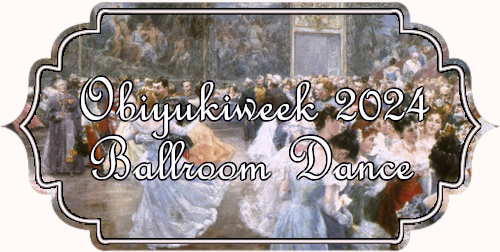
Welcome back one and all to our ninth annual Obiyuki Week! Our theme this year is:
Ballroom Dance
Each day will have a form of dance for a prompt, as well as a few themes that can be used to inspire works or continue existing ones. This ship week is open to all Obiyuki works, so even if a submission does not quite fit the day, please feel free to post and join in!
Day 1: Quadrille

Introduced in France around 1760, the Quadrille quickly became popular in 18th and 19th century ballrooms across Europe. It is performed by four couples in a square, with one couple at a time dancing while the other three rest. Although not performed in modern competitions, the quadrille late gave rise to other popular forms of dance, such as the waltz and American square dancing.
Themes: Change of Partners, Ensemble Piece, Meddling Matchmakers; White
Day 2: Foxtrot
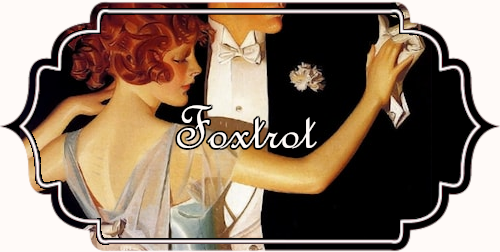
Premiering in 1914, the Foxtrot was first danced to ragtime music before becoming the dance of choice for big bands from the late 1910s through the 1940s. Known for its elegant glide across the dance floor and quick steps, the foxtrot has since split into slow and quick versions-- also known as the quickstep
Themes: Compatibility, Banter, Swept Off Their Feet; Blue
Day 3: Paso Doble

Originating in Spain, the Paso Doble's dramatic steps are meant to imitate the movements of a bullfight, with the lead playing matador and the follow being either cape or bull. It is often known as the "man's dance," since it displays the lead position-- traditionally male-- to its best advantage.
Themes: Conflict, Obi POV, Vying For Dominance; Red
Day 4: Viennese Waltz
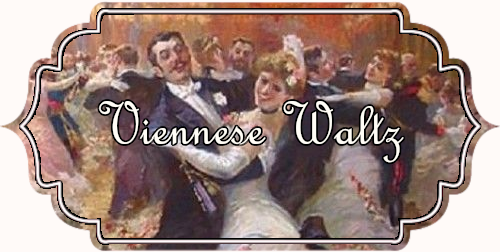
The first ballroom dance to be danced in closed position-- aka, partners hold each other while facing toward each other-- the Viennese Waltz caused a scandal when it was introduced in late 18th century ballrooms. It became fashionable during the Regency period, though it remained "riotous and indecent" as late 1825.
Themes: Scandal, Tradition, Falling in Love; Silver
Day 5: Rhumba
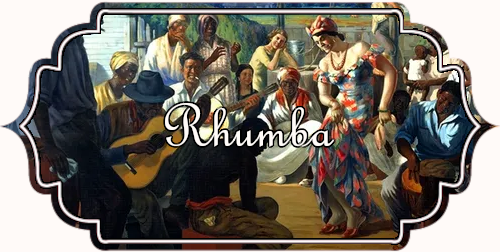
The slowest of the Latin dances performed in modern competition, the Rhumba was first danced in the streets of Cuba before gaining popularity in the early 20th century and becoming what is now known as Ballroom Rumba. Known for its sensual movements and emphasis on hips, it is both known as the "dance of love" and the "woman's dance" for showing off the skill of its follow.
Themes: Intimate, Shirayuki POV, Hips Don't Lie; Green
Day 6: Tango
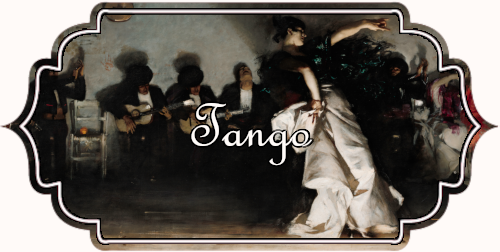
Another dance tamed to the tastes of ballroom-goers, the Tango originated as an improvisational dance in the lower-class neighborhoods of Buenos Aires and was brought to the United States by immigrants in the early 20th century. It is characterized by drama and passion and precise footwork.
Themes: Passion, Close Quarters, Rivals-to-Lovers; Black
Day 7: West Coast Swing (Free Day)
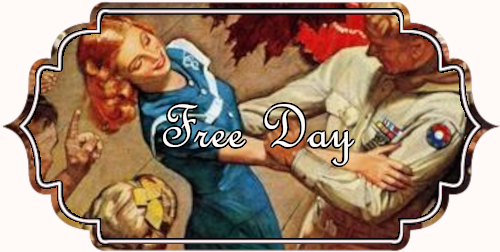
Evolving from the Lindy Hop of the 1930s, West Coast Swing started as an adaptation of the dance to fit a more crowded dance floor, before gaining popularity as a style all its own in the 1960s. Meant to be improvisational and playful, it best showcases the connection between partners.
Themes: Improvising, Adventure, Friends-to-Lovers; Gold
Dates: September 22nd-28th Tag: #obiyukiweek24
[Guidelines beneath cut]
Guidelines:
All work must be your own (eg. no plagiarizing other sources, tracing, pose stealing, AI art/writing etc)
The main pairing is Obi x Shirayuki
Must follow the day’s prompt, however loosely
Must be tagged #obiyukiweek24 within the first five tags
With Tumblr’s tagging system on the fritz, please also @ snowwhite-andtheknight in your entry
Please label with the day’s number!
All NSFWcontent must be tagged and under a Read More!
You may submit multiple entries for each day!
Be nice
Play hard
#obiyukiweek24#obiyuki#shiraobi#shirayuki x obi#akagami no shirayukihime#snow white with the red hair
69 notes
·
View notes
Text
Some thoughts about things on Bang Bravern… (bit long, sorry)

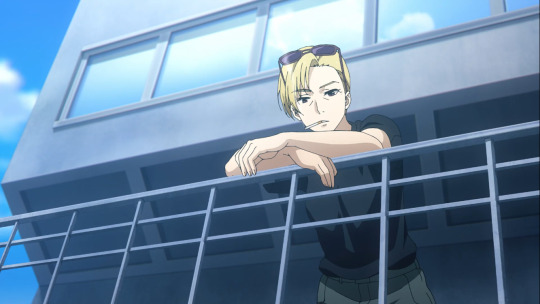
Why do I clock the German major general Heidemarie as a lesbian?




So what if “ga-ga-pi” is some kind of a code, similar to Morse code or the binary code? Lulu has her “ga-ga-pi.” The other Deathdrive has its “ga-ga-ga. Pi-ga-ga-ga-pi. Pi-ga-ga-pi-ga.” The sequence is different in order to convey another meaning. The only solution is how to interpret it. Or perhaps, I am just overthinking.
So what are the Death Drives?
From the series’s glossary:
Death Drives : A mysterious mechanical life form that suddenly attacked the earth. Their goal is to achieve the best "death" that each of them wants. They came to this earth around all the galaxies in search of an existence that will fulfil their wishes.
Those drives sound like a part of Sigmund Freud’s psychoanalysis’ theory, the theory of pleasure principle (Lustprinzip).
Did Masami Obari, the director, turn to the Austrian psychoanalyst to gather the blueprint for his latest work?
(I know that Freud doesn’t have many fans among the Tumblr folks. But he “is” my neighbour. After having seen “Freud’s Vanished Neighbors” and read an article that the Viennese didn’t accept him as part of the community because he was not born in Austria and had Jewish family, and was still referred to as “Zugeraster,” a derogatory term for an outsider, he earned my respect and like everyone who was born centuries ago had other mentality that was not at all fitting in the modern era.)
Deathdrives, or death drives, in Freudian psychoanalytical universe, mean Thanatos, Todestrieb in German, is a term that describes: the drive toward death and destruction, often expressed through behaviors such as aggression, repetition compulsion, and self-destructiveness.
From Freud’s book, “Beyond the Pleasure Principle” :
Our departure point was the great antithesis of life drives and death drives. Object-love itself shows us a second such polarity – that of love (affection) and hate (aggression). What if we succeeded in connecting these two polarities, what if we succeeded in tracing one back to the other! We have always acknowledged a sadistic component in the sexual drive; as we know, this component can develop a life of its own and turn into a perversion that dominates a person's entire sexual life. It also occurs as a dominant partial drive in one of those forms of organization of sexual life that I have termed ‘pre-genital’. But how could we possibly suppose that the sadistic drive, which aims to harm its object, derives from Eros, the preserver of life? Isn't it altogether plausible to suppose that this sadism is actually a death drive that has been ousted from the ego at the instance of the narcissistic libido, and as a result only becomes apparent in conjunction with the object?
So you have the enemies, the Death Drives, ready to destroy the humans, and Bravern on the other with the quality of being the Eros. The sentient robot’s ethos is to save the humanity first. All the while obsessing with his pilot, Ao Isami. Obsession and kindness overlapping.


@whypolar analysed their names, then doing some googling of the meanings of both Isami and Lewis’ names, it seems the two share the same description. Yours truly is not at all a Japanese language expert, this website suggests that Isami has 21 variations in kanji.
勇 means "bravery, courage."
Brave - Showing courage and strength in the face of danger or difficulty.
Daring - Willing to take risks and try new things.
Strong - Having great physical or mental power.
Courageous - Having or showing courage in the face of danger or difficulty.
Resolute - Firmly determined to do something.
Soldier - A person who serves in an army.
It describes Isami’s personality perfectly!
Lewis, on the other hand…
From the celebrated author of Alice's Adventures in Wonderland, Lewis Carroll, to lauded actor Daniel-Day Lewis, a boy called Lewis is in good company! Lewis is of German origin and means "Renowned warrior." It has many variations in Latin, French, and Gaelic languages that all point to the same sentiment of “strength” and “courage”. With the name Lewis, you can hope to instill your baby boy with a fearless optimism for life.
All three of them—Bravern, Isami and Lewis—are “strong and courageous.”
#bang brave bang bravern#yuuki bakuhatsu bang bravern#ao isami#lewis smith#isami x lewis#heidemarie#death drive#sigmund freud#masami obari#bravern thoughts
80 notes
·
View notes
Text


Liechtenstein Candy Charm Design
Includes:
-Fürstenhütchen
- Hofkellerei des Fürsten von Liechtenstein (Wine from the prince of Liechtenstein)
- Liechtensteiner Ribel
- Liechtensteiner Krömle (cookies but in the shape of Liechtenstein)
History Bar Code:
1342 - The county of Vaduz was founded due to a split of the county of Werdenberg
1681 - End of the witch trials of Triesen, between 1598 and 1680 more than 100 people were accused for witchcraft
1719 - The modern country of Liechtenstein was formed. (Funfact: Because of Ferdinand Karl von Hohenems' debts due to the witch trials, his younger brother had to sell Vaduz and Schellenberg to Johann Adam I. of Liechtenstein. That means the year and event I've referenced before also lead to this one, in a way, lol, but I found it out afterwards)
1806 - Liechtenstein gains souvereignity within the Rhine Confederation
1815 - At the Viennese Congress, Liechtenstein was officially seen as an independent country within the German Confederation
Finding Liechtensteiner treats was kinda hard because I barely found sth outside of the official website for tourism in Liechtenstein. The Krömle is just a cookie someone made for a Christmas Market and I thought it was cute. Ribel is somewhat of a national dish there but the Fürstenhütchen are actual pralines Liechtenstein is known for and the wine is from the winery of the Liechtensteiner prince himself 🎀
The Fürstenhütchen pralines are also my inspiration for Liechtenstein's candy bag name: Fürstenkrönchen. Meaning: Prince's Crown (Krönchen means Krone/crown but cutiefied and in a diminutive ❤️)
#hetalia#my art#hetalia candy bag charms#aph liechtenstein#hws liechtenstein#hetalia liechtenstein#My favourite design tbh
19 notes
·
View notes
Note
Random language thing: I was watching a cellbit vod and noticed afterwards that I was thinking a lot more in german than I usually do. I realised that Portugese (at least the way cellbit speaks) is really similar inflection-wise to my native Viennese dialect, which probably caused that phenomenon .
Given yiddish has a lot in common with (southern) german, is this something you've also noticed? I feel like portugese has a lot more phonemes in common with german than english, which surprised me!
oh that's super interesting! i would say ive never heard (knowingly) southern german dialects, so i wouldn't be able to say for certain, but yiddish actually comes from very very old high german (around 10th-12th centuries primarily) that developed in the rhineland, so what ive been told by most german speakers is that it sounds like medieval peasant german more than anything else-- akin to what medieval english would sound like to modern english speakers. so i can understand a fair bit of german (and other germanic languages) but i wouldn't say they're super similar in sound, at least to my ears.
for me i think that kind of thing, of getting into a certain language mode when interacting with a different language, is just very common, and you're right that it tends to happen when there's similar elements across languages. i used to speak spanish in yiddish class all the time because there's a few things in common (and spanish was my first second language, so it's always my default and my comparison for all others), and the same in hebrew class because the phonetic-ness of hebrew reminds me a lot of spanish (and obviously yiddish and hebrew have a ton of crossover, so that gave me a definite leg up there).
portuguese has VERY different inflections to yiddish imo– yiddish tends to be much flatter on the vowels and is musical but in a very different way. portuguese to my ears is very unique in terms of inflection and rhythm, even compared to spanish.
back to that language mode point, though, i do think there's a lot to be said for that part of your brain lighting up and then reaching for a different language than you're actually hearing– i think that's very much the multilingual experience.
#asks#anons#language talk#i think it would be fun to try to have a conversation with someone where im speaking yiddish#and theyre speaking german and see how mutually discernible it is#ive been able to watch movies in german and understand most of them but i believe it doesn't quite work the same way the other way around#although yiddish has so much hebrew and aramaic that im sure thats a big part of it
12 notes
·
View notes
Text

Franziska Kantor
Versuch einer kinetistischen Plastik (Wiedergabe des rhythmischen Ablaufs einer Bewegung/Tänzerin), 1922
13 notes
·
View notes
Text

The Kiss (1908-1909) 🎨 Gustav Klimt 🏛️ Belvedere 📍 Vienna, Austria
“The Kiss”, probably the most popular work by Gustav Klimt, was first exhibited in 1908 at the Kunstschau art exhibition on the site of today’s Konzerthaus. The Ministry bought it from there for the sum of 25,000 Kronen and thus secured for the state one of the icons of Viennese Jugendstil and indeed of European modern art. It undoubtedly represents the culmination of the phase known as the “Golden Epoch”. In this decade, the artist created a puzzling, ornamental encoded programme that revolved around the mystery of existence, love and fulfilment through art. Klimt gained initial inspiration for this in 1903 on a journey to Ravenna to see the Byzantine mosaics. In addition, the painting contains a myriad of motifs from various cultural epochs, above all from Ancient Egyptian mythology. Most recent research has, however, revealed that it is not enough to read the ornaments in the picture just as symbols rooted in tradition aiming to convey a timelessly valid message. They reveal more, such as references to Klimt’s love for Emilie Flöge and the artist’s exploration of the sculptor Auguste Rodin’s art.
#The Kiss#Gustav Klimt#1908#1909#Belvedere#Vienna#Austria#painting#oil painting#oil on canvas#Art Nouveau#Modern art#Symbolism#Der Kuss (Liebespaar)#austrian#art#artwork#art history
31 notes
·
View notes
Text

Gustav Klimt Portrait Found After Vanishing Nearly 100 Years Ago
It is one of the last works the artist painted before his death in 1918.
One of the last paintings by the renowned Austrian artist Gustav Klimt has miraculously been found after vanishing nearly 100 years ago.
The painting, titled Portrait of Fräulein Lieser, was found in Vienna after last being seen by the public in 1925. Until now, the only known photograph of the painting had been held in the archives of the Austrian National Library. The picture was likely taken in 1925 in connection with the Klimt exhibition by Otto Kallir-Nirenstein in the Neue Galerie, Vienna.
Since then, its location had been a mystery.
"The rediscovery of this portrait, one of the most beautiful of Klimt's last creative period, is a sensation," said the im Kinsky auction house in a statement announcing the discovery. "As a key figure of Viennese Art Nouveau, Gustav Klimt epitomizes fin de siècle Austrian Modernism more than any other artist. His work, particularly his portraits of successful women from the upper middle class at the turn of the century, enjoy the highest recognition worldwide."
The work of art will go up for auction at the im Kinsky auction house in Vienna on April 24 and is expected to fetch millions on the market.
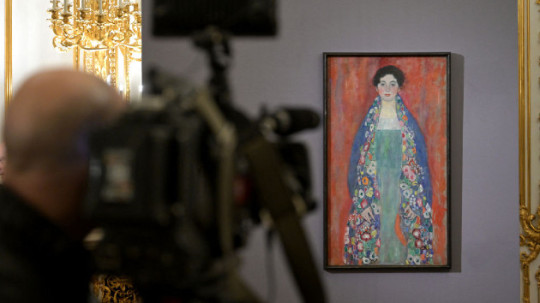
"Klimt's paintings rank in the top echelons of the international art market. His portraits of women are seldom offered at auctions. A painting of such rarity, artistic significance, and value has not been available on the art market in Central Europe for decades," im Kinsky auction house said. "This also applies to Austria, where no work of art of even approximate importance has been available."
The painting will now travel worldwide on short exhibitions until it is auctioned and is set to be presented at various locations internationally, including stops in Switzerland, Germany, Great Britain and Hong Kong.
The model for the painting is labeled as Fräulein Lieser, also known as Margarethe Constance Lieser (1899-1965), daughter of the Austrian industrial magnate Adolf Lieser. But new research by the im Kinsky auction house into the history and provenance of the masterpiece has opened up the possibility that Klimt's model could have been another member of the Lieser family -- either Helene Lieser (1898-1962), the first-born of Henriette Amalie Lieser-Landau and Justus Lieser, or their younger daughter, Annie Lieser (1901-1972), according to officials.
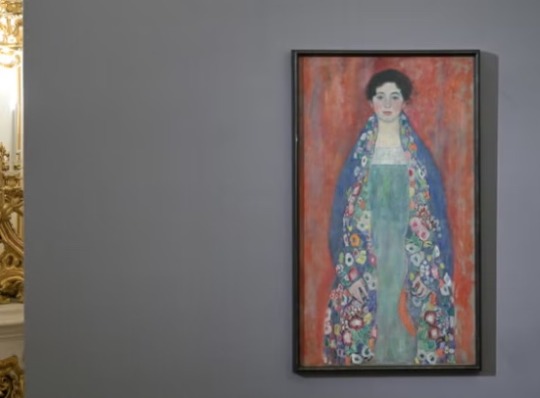
"In April and May 1917, the sitter visited Klimt's studio in Hietzing nine times to pose for him," im Kinsky said. "Klimt probably began the painting in May 1917. The painter chose a three-quarter portrait for his depiction and shows the young woman in a strictly frontal pose, close to the foreground, against a red, undefined background. A cape richly decorated with flowers is draped around her shoulders."
The portrait is thought to be one of Klimt's last paintings and was done shortly before he died of a stroke on Feb. 6, 1918. The painting was left, with several small portions of it unfinished, in his studio and it is thought that the painting was given to the family who had commissioned it after his death.
The painting, however, would soon vanish and the exact fate of the painting after 1925 is unclear.
"What is known is that it was acquired by a legal predecessor of the consignor in the 1960s and went to the current owner through three successive inheritances," im Kinsky auction house said.
ByJon Haworth.

#Gustav Klimt#Gustav Klimt Portrait Found After Vanishing Nearly 100 Years Ago#Gustav Klimt Portrait of Fräulein Lieser#austrian artist#painter#painting#art#artist#art work#art world#art news#history#history news
70 notes
·
View notes
Text
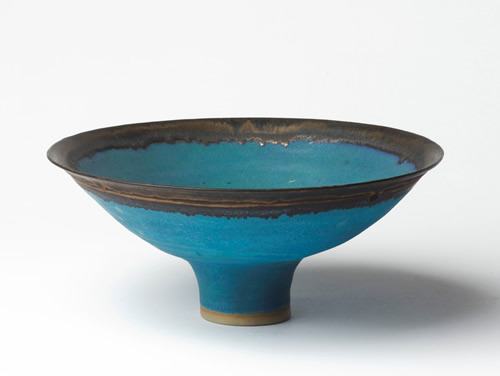






The Pioneering Pottery of Lucie Rie
by Robin Cawdron-Stewart.
"Very few people in this country think of the making of pottery as an art" – so wrote Bernard Leach in May 1940. Yet the pottery that Leach wrote of – with "its own language and inherent laws"- had a presence within the broader British Arts scene since the beginning of the century through the likes of the Omega Workshops and the Seven & Five Society.
Today ceramics are held in equal esteem to the mediums of painting and sculpture, and clay celebrated for its great breadth and versatility. And whilst no single potter alone can be credited with this great accomplishment, the work of Lucie Rie has done much to promote studio ceramics, presenting them to a truly global audience.
Born in Vienna in 1902, Rie grew up in an environment steeped in the style and elegance of Viennese Modernism and enrolled at the Vienna Kumstgewerbeschule in 1922 where she learnt to throw. It was also whilst a student that she began to develop her in-depth scientific understanding and fascination with glazes – something which stayed with her throughout her life. Rie established a name for herself on the continent, winning prizes for her work at the International Exhibition in Paris in 1937 but following the Anschluss and the union of Austria with Nazi Germany she fled Vienna and, together with her husband, arrived in London.
The Britain that Rie arrived into was a world away from Vienna, both socially and in terms of the artistic environment and the ceramic scene. British studio pottery was dominated by the work and writings of Bernard Leach, who looked back to the historic craft tradition or further afield to the Japanese aesthetic. Rie grappled with this very alien approach, and despite her efforts, could not divorce herself from the European and Modernist ideals that she had learned on the continent."
Continue https://www.sothebys.com/.../art.../lucie-rie-pioneer-potter
23 notes
·
View notes
Photo

Embodied Histories: New Womanhood in Vienna, 1894–1934
"Embodied Histories" by Katya Motyl explores the intersection of gender, modernity, and urban culture in Vienna during the late-19th and early-20th centuries. This book is an enlightening resource for university students focusing on modern European history.
When first picking up this book, the reader might not expect to stumble upon police reports regarding wrongful arrests of Viennese women at the turn of the century. As a contemporary reader, what is provided on the pages of Katya Motyl’s new book is enlightening yet infuriating.
Embodied Histories: New Womanhood in Vienna, 1894–1934 by Katya Motyl explores the intersection of gender, modernity, and urban culture in Vienna during the late-19th and early-20th centuries. Motyl is a cultural and social historian, Assistant Professor of History, and Affiliate Faculty of the Gender, Sexuality, and Women’s Studies Program at Temple University.
Her book, written successfully and with expert knowledge, focuses on the "New Woman" concept and is aimed at scholars and students of global history and gender studies. The New Woman, described by Motyl, was symbolic of changing traditional gender roles and aspirations among women in Vienna whether she was aware of the change or not.
Through a combination of historical analysis and cultural critique, Motyl examines various aspects of the experiences of the New Woman in each chapter. These include her participation in public life, her engagement with emerging feminist movements, her portrayal in literature and art, and her embodiment in fashion and lifestyle choices. Motyl offers readers an in-depth discovery of unbearably truthful historical scenarios based on her thorough research of documents, including police reports, court records, and more. This well-rounded research approach makes the book compelling, unique, and a must-read for anyone studying European history, women’s history, or sexuality.
According to Motyl, at the turn of the century, women in Vienna were apprehended by police simply for walking outside at night or dressing in non-traditional feminine outfits. The eye-opening and informative stories and the voices of the women affected are revealed throughout the text. The instances of women unable to speak freely about their emotions or thoughts are also mentioned, giving readers insight as to why human rights and women's rights are important yet still challenged today.
Outlets such as theater or sanatorium visits were usually the only means of expression for women in Vienna during this time. The information included in this often heart-wrenching text is sewn together with various forms of artwork. Tying the stories together with cartoons, sketches, and even the era's political drawings showcases society and gender norms, displaying the mindset of people who lived during the turn of the century in Vienna.
The adoption of new styles and beliefs together with the rejection of outdated norms during this period were seen as significant acts of rebellion, leading to police interactions, as women searched for self-expression. With this book, their experiences are brought to light. Embodied Histories reflects broader changes in gender roles of women and societal expectations of them in early 20th-century Europe, laying the groundwork for further advancements of women’s rights and social equality in the future.
Katya Motyl has contributed a significant gift to cultural and social history research with her book. Motyl's effort in demonstrating how Viennese women contributed to and were shaped by the city's dynamic cultural milieu offers insights into their individual experiences and collective impact on society.
Continue reading...
23 notes
·
View notes